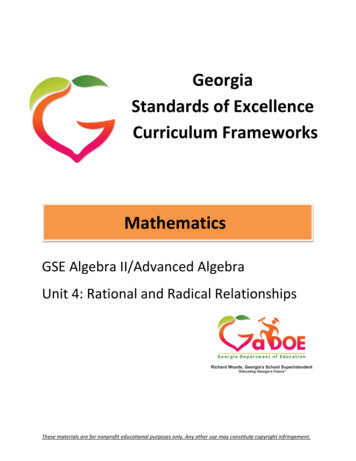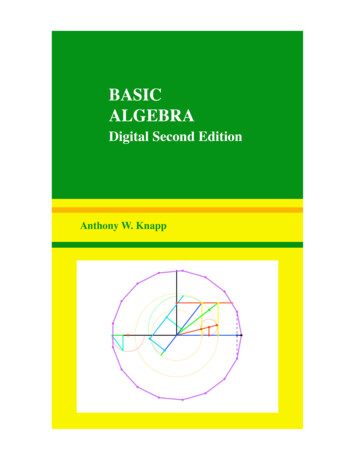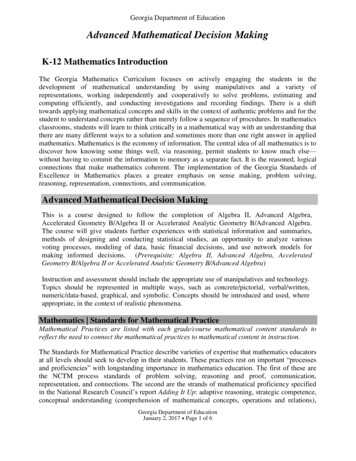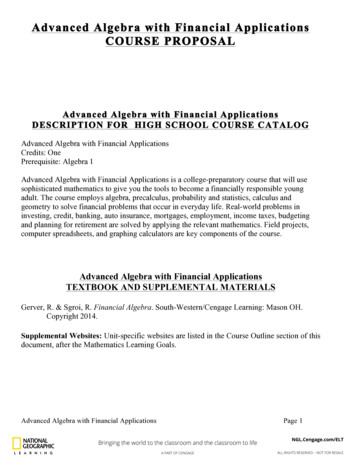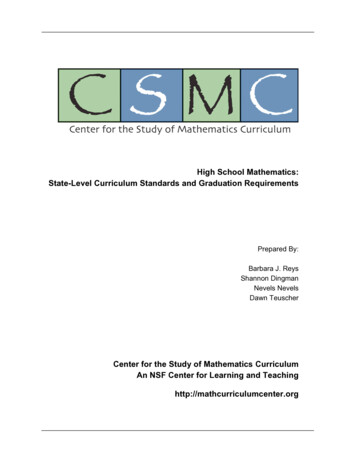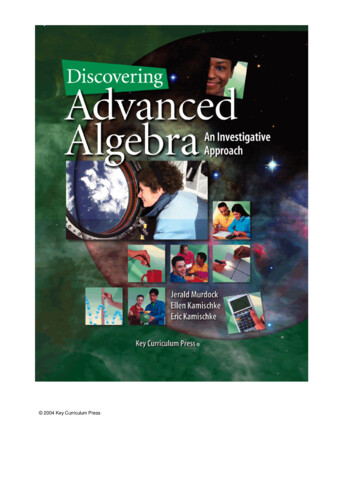
Transcription
Discovering Advanced Algebra i1 de ingCourses/DAA/fr. 2004 Key Curriculum Press31-03-2009 18:42
Discovering Advanced Algebra i1 de ingCourses/DAA/c. 2004 Key Curriculum Press31-03-2009 18:43
Contribute1 de ingCourses/DAA/c.Project EditorLadie MalekProject AdministratorShannon MillerEditorsChristian Aviles-Scott, Josephine NoahEditorial AssistantsErin Gray, Eric Martin, Susan Minarcin, Sigi Nacson,Jason TaylorEditorial ConsultantsLarry Copes, Fred Decovsky, Heather Dever, DanDitty, David RasmussenMathematical Content ReviewerJames Wilson, Ph.D., University of Georgia, Athens,GeorgiaMulticultural and Equity ReviewerSwapna Mukhopadhyay, Ph.D., Portland StateUniversity, Portland, OregonTeacher ReviewersJennifer North Morris, Santa Rosa High School, SantaRosa, CaliforniaWilliam Putnam, John Marshall High School,Rochester, MinnesotaScientific Content ReviewerArt Fortgang, Mills High School, Millbrae, CaliforniaAccuracy CheckersDudley Brooks, Cavan Fang, Monica Johnston,Abby TanenbaumEditorial Production ManagerDeborah CoganProduction EditorChristine OsborneCopyeditorMargaret MooreProduction DirectorDiana Jean RayProduction CoordinatorAnn RothenbuhlerCover DesignerJill KongabelText DesignerMarilyn PerryArt EditorJason LuzPhoto EditorMargee RobinsonArt and Design CoordinatorCaroline AyresIllustratorsRobert Arnow, Pamela Hobbs, William Pasini, Sue ToddTechnical ArtMatt Perry, Jason LuzCompositor and PrepressTSI GraphicsPrinterVon Hoffmann PressExecutive EditorCasey FitzSimonsPublisherSteven Rasmussen 2004 by Key Curriculum Press. All rights reserved.No part of this publication may be reproduced, stored in aretrieval system, or transmitted, in any form or by any means,electronic, photocopying, recording, or otherwise, withoutthe prior written permission of the publisher. The Geometer’s Sketchpad, Dynamic Geometry, and KeyCurriculum Press are registered trademarks of KeyCurriculum Press. The Discovering Mathematics logo andSketchpad are trademarks of Key Curriculum Press. Fathom Dynamic Statistics is a trademark ofKCP Technologies.All other trademarks are held by their respective owners.This material is based upon work supported by the NationalScience Foundation under award number MDR9154410.Any opinions, findings, and conclusions or recommendationsexpressed in this publication are those of the authors and donot necessarily reflect the views of the National ScienceFoundation.Key Curriculum Press1150 65th StreetEmeryville, CA 94608editorial@keypress.comwww.keypress.comPrinted in the United States of America10 9 8 7 6 5 4 3 2 1 08 07 06 05 04 03ISBN 1-55953-606-3 2004 Key Curriculum Press31-03-2009 18:43
Acknowledgments iii1 de ingCourses/DAA/a.a textbook and its supplementary materials is a team effort involvingCreatingmany individuals and groups. We are especially grateful to thousands ofAdvanced Algebra Through Data Exploration and Discovering Algebra teachers andstudents, to teachers who participated in the summer institutes and workshops,and to manuscript readers, all of whom provided suggestions, reviewed material,located errors, and most of all, encouraged us to continue with the project.Our students, their parents, and our administrators at Interlochen Arts Academyhave played an important part in the development of this book. Most importantly,we wish to thank Carol Murdock, our parents, and our children for their love,encouragement, and support.As authors we are grateful to the National Science Foundation for supportingour initial technology-and-writing project that led to the 1998 publication ofAdvanced Algebra Through Data Exploration. Discovering Advanced Algebra hasbeen developed and shaped by what we learned during the writing and publicationof both Advanced Algebra Through Data Exploration and Discovering Algebra, andour work with so many students, parents, and teachers who were searching for amore meaningful algebra curriculum.Over the course of our careers, many individuals and groups have beeninstrumental in our development as teachers and authors. The Woodrow WilsonNational Fellowship Foundation provided the initial impetus for involvement inleading workshops. Publications and conferences produced by the NationalCouncil of Teachers of Mathematics and Teachers Teaching with Technology haveguided the development of this curriculum. Individuals such as Ron Carlson,Helen Compton, Frank Demana, Arne Engebretsen, Paul Foerster, Christian Hirsch,Glenda Lappan, Richard Odell, Heinz-Otto Peitgen, James Sandefur, James Schultz,Dan Teague, Charles VonderEmbse, Bert Waits, and Mary Jean Winter haveinspired us.The development and production of Discovering Advanced Algebra has been acollaborative effort between the authors and the staff at Key Curriculum Press.We truly appreciate the cooperation and valuable contributions offered by theEditorial and Production Departments at Key Curriculum Press. Finally, a specialthanks to Key’s president, Steven Rasmussen, for encouraging and publishing atechnology-enhanced Discovering Mathematics series that offers groundbreakingcontent and learning opportunities.Jerald MurdockEllen KamischkeEric Kamischke 2004 Key Curriculum Pressiii31-03-2009 18:44
A Note from the Publisher iv1 de ingCourses/DAA/a.you find in this book won’t look quite like the algebra you may haveTheseenalgebrain older textbooks. The mathematics we learn and teach in school has tochange continually to reflect changes in our world. Our workplaces are changing,and technology is present everywhere, fundamentally changing the work we do.There are some new topics that are now possible to explore with technology, andsome standard topics that can be approached in new ways. As the NationalCouncil of Teachers of Mathematics (NCTM) Technology Principle says, “Whentechnological tools are available, students can focus on decision making, reflection,reasoning, and problem solving.” This has been the focus of the authors and theKey Curriculum Press editorial team in the creation of Discovering AdvancedAlgebra: An Investigative Approach. As you progress through this book, you’ll seethat graphing calculators and other technologies are used to explore patterns andto make, test, and generalize conjectures.When Key Curriculum Press published the first version of this text, AdvancedAlgebra Through Data Exploration: A Graphing Calculator Approach, in 1998, fewbooks were available that had a similar foundation in technology. In this revision,you’ll see that that foundation has been enriched with projects, explorations,and exercises that utilize not only graphing calculators, but also the powerfulanalysis tools The Geometer’s Sketchpad and Fathom Dynamic Statistics .Based on feedback from users and reviewers, this revision is reorganized andeasier to read. Discovering Advanced Algebra also completes the fully updatedDiscovering Mathematics series. All of the features that make Discovering Algebraand Discovering Geometry innovative and exciting are now incorporated into thisbook as well, to make a coherent and streamlined series.Investigations are at the heart of each book. Through the investigations, you’llexplore interesting problems and generalize concepts. And if you, as a student,forget a concept, formula, or procedure, you can always re-create it—because youdeveloped it yourself the first time! You’ll find that this approach allows you toform a deep and conceptual understanding of advanced algebra topics.As Glenda Lappan, mathematics professor at Michigan State University and formerNCTM president, said about the first edition of this book, “Students coming outof a year with this text . . . will know the mathematics they know in deeper, moreflexible ways. They will have developed a set of mathematical habits of mind thatwill serve them very well as students or users of mathematics. They will emergewith a sense of mathematics as a search for regularity that allows prediction.”If you are a student, we hope that what you learn this year will serve you well inlife. If you are a parent, we hope you will enjoy watching your student developmathematical confidence. And if you are a teacher, we hope Discovering AdvancedAlgebra greatly enriches your classroom. The professional team at Key CurriculumPress wishes you success and joy in the lifetime of mathematics ahead of you.We look forward to hearing about your experiences.Steven Rasmussen, PresidentKey Curriculum Pressiv 2004 Key Curriculum Press31-03-2009 18:44
Contents Page V1 de ingCourses/DAA/co.A Note to Students from the AuthorsCHAPTERProblem Solving0.1 Pictures, Graphs, and DiagramsInvestigation: Camel Crossing the Desert0.2 Symbolic RepresentationInvestigation: Problems, Problems, ProblemsProject: Create Your Own Computer Icon0.3 Organizing InformationInvestigation: Who Owns the Zebra?Chapter 0 ReviewTake Another LookAssessing What You've LearnedCHAPTERxiiiPatterns and Recursion1.1 Recursively Defined SequencesInvestigation: Monitoring Inventory1.2 Modeling Growth and DecayInvestigation: Looking for the Rebound1.3 A First Look at LimitsInvestigation: Doses of Medicine1.4 Graphing SequencesInvestigation: Match Them UpExploration:Recursion in GeometryActivity: Two Spirals1.5 Loans and InvestmentsInvestigation: Life’s Big ExpendituresProject: The Pyramid Investment PlanExploration:Refining the Growth ModelActivity: Cornering the MarketChapter 1 ReviewTake Another LookAssessing What You’ve Learned 2004 Key Curriculum 66768717475v31-03-2009 18:44
Contents Page VI1 de ingCourses/DAA/co.CHAPTERCHAPTERviDescribing Data2.1 Measures of Central Tendency and Box PlotsInvestigation: Pulse Rates2.2 Measures of SpreadInvestigation: A Good Design2.3 Histograms and Percentile RanksInvestigation: Eating on the RunProject: Stem-and-Leaf PlotsExploration:Census MicrodataActivity: Different Ways to Analyze DataChapter 2 ReviewTake Another LookAssessing What You’ve Learned76778085859498104105106108111112Linear Models and Systems3.1 Linear Equations and Arithmetic SequencesInvestigation: Match Point3.2 Revisiting SlopeInvestigation: Balloon Blastoff3.3 Fitting a Line to DataInvestigation: The WaveProject: Talkin’ Trash3.4 The Median-Median LineInvestigation: Spring ExperimentProject: Counting Forever3.5 ResidualsInvestigation: Airline SchedulesExploration:Residual Plots and Least SquaresActivity: A Good Fit?3.6 Linear SystemsInvestigation: Population Trends3.7 Substitution and EliminationInvestigation: It All Adds UpChapter 3 ReviewMixed ReviewTake Another LookAssessing What You’ve 49151152157159164166169170 2004 Key Curriculum Press31-03-2009 18:44
Contents Page rtingCourses/DAA/co.CHAPTERCHAPTERFunctions, Relations, and Transformations4.1 Interpreting GraphsInvestigation: Graph a Story4.2 Function NotationInvestigation: To Be or Not to Be (a Function)Project: Step Functions4.3 Lines in MotionInvestigation: Movin’ Around4.4 Translations and the Quadratic FamilyInvestigation: Make My Graph4.5 Reflections and the Square Root FamilyInvestigation: Take a Moment to ReflectExploration: Rotation as a Composition of TransformationsActivity: Revolution4.6 Stretches and Shrinks and the Absolute-Value FamilyInvestigation: The Pendulum4.7 Transformations and the Circle FamilyInvestigation: When Is a Circle Not a Circle?4.8 Compositions of FunctionsInvestigation: Looking UpProject: Boolean GraphsChapter 4 ReviewTake Another LookAssessing What You’ve LearnedExponential, Power, and Logarithmic Functions5.1 Exponential FunctionsInvestigation: Radioactive DecayProject: The Cost of Living5.2 Properties of Exponents and Power FunctionsInvestigation: Properties of Exponents5.3 Rational Exponents and RootsInvestigation: Getting to the RootProject: Powers of 105.4 Applications of Exponential and Power Equations5.5 Building Inverses of FunctionsInvestigation: The Inverse5.6 Logarithmic FunctionsInvestigation: Exponents and Logarithms5.7 Properties of LogarithmsInvestigation: Slide Rule5.8 Applications of LogarithmsInvestigation: CoolingProject: Income by Gender 2004 Key Curriculum Press1 de 261266266273273279280286289292vii31-03-2009 18:45
Contents Page VIII1 de ingCourses/DAA/co.CHAPTERCHAPTERviiiExploration: The Number eActivity: Continuous GrowthProject: All About eChapter 5 ReviewTake Another LookAssessing What You’ve LearnedMatrices and Linear Systems6.1 Matrix RepresentationsInvestigation: Chilly Choices6.2 Matrix OperationsInvestigation: Find Your Place6.3 Row Reduction MethodInvestigation: League Play6.4 Solving Systems with Inverse MatricesInvestigation: The Inverse Matrix6.5 Systems of Linear InequalitiesInvestigation: Paying for College6.6 Linear ProgrammingInvestigation: Maximizing ProfitProject: Nutritional ElementsChapter 6 ReviewMixed ReviewTake Another LookAssessing What You’ve LearnedQuadratic and Other Polynomial Functions7.1 Polynomial Degree and Finite DifferencesInvestigation: Free Fall7.2 Equivalent Quadratic FormsInvestigation: Rolling Along7.3 Completing the SquareInvestigation: Complete the Square7.4 The Quadratic FormulaInvestigation: How High Can You Go?Project: Calculator Program for the Quadratic Formula7.5 Complex NumbersInvestigation: Complex ArithmeticProject: The Mandelbrot Set7.6 Factoring PolynomialsInvestigation: The Box Factory7.7 Higher-Degree PolynomialsInvestigation: The Largest Triangle7.8 More About Finding 79385387390391393397398400405406412 2004 Key Curriculum Press31-03-2009 18:45
Contents Page IX1 de ingCourses/DAA/co.CHAPTERCHAPTER 2004 Key Curriculum PressChapter 7 ReviewTake Another LookAssessing What You’ve LearnedParametric Equations and Trigonometry8.1 Graphing Parametric EquationsInvestigation: Simulating Motion8.2 Converting from Parametric to Nonparametric EquationsInvestigation: Parametric Walk8.3 Right Triangle TrigonometryInvestigation: Two ShipsExploration: Parametric Equations for a CircleActivity: Variations on a Circle8.4 Using Trigonometry to Set a CourseInvestigation: Motion in a CurrentProject: Viewing Angle8.5 Projectile MotionInvestigation: Basketball Free Throw8.6 The Law of SinesInvestigation: Oblique Triangles8.7 The Law of CosinesInvestigation: Around the CornerProject: CatapultChapter 8 ReviewTake Another LookAssessing What You’ve LearnedConic Sections and Rational Functions9.1 Using the Distance FormulaInvestigation: Bucket Race9.2 Circles and EllipsesInvestigation: A Slice of Light9.3 ParabolasInvestigation: Fold a Parabola9.4 HyperbolasInvestigation: Passing ByExploration: Constructing the Conic SectionsActivity: From Circles to the Ellipse9.5 The General QuadraticInvestigation: Systems of Conic EquationsExploration: The Rotation MatrixActivity: Around We Go9.6 Introduction to Rational FunctionsInvestigation: The Breaking 1514518523523525529534534536536ix31-03-2009 18:45
Contents Page X1 de ingCourses/DAA/co.9.7CHAPTERxGraphs of Rational FunctionsInvestigation: Predicting Asymptotes and HolesProject: Going Downhill Fast9.8 Operations with Rational ExpressionsProject: Cyclic HyperbolasChapter 9 ReviewMixed ReviewTake Another LookAssessing What You’ve LearnedTrigonometric Functions10.1 Defining the Circular FunctionsInvestigation: Paddle Wheel10.2 Radian Measure and Arc LengthInvestigation: A Circle of Radians10.3 Graphing Trigonometric FunctionsInvestigation: The Pendulum II10.4 Inverses of Trigonometric FunctionsInvestigation: Exploring the InversesProject: Design a Picnic Table10.5 Modeling with Trigonometric EquationsInvestigation: A Bouncing SpringProject: A Dampened Sine Curve10.6 Fundamental Trigonometric IdentitiesInvestigation: Pythagorean Identities10.7 Combining Trigonometric FunctionsInvestigation: Sound WaveExploration:Polar CoordinatesActivity: Rose CurvesChapter 10 ReviewTake Another LookAssessing What You’ve 83585594595600601603608609610615616622623625627628 2004 Key Curriculum Press31-03-2009 18:46
Contents Page XI1 de ingCourses/DAA/co.CHAPTERSeries11.1 Arithmetic SeriesInvestigation: Arithmetic Series Formula11.2 Infinite Geometric SeriesInvestigation: Infinite Geometric Series Formula11.3 Partial Sums of Geometric SeriesInvestigation: Geometric Series FormulaExploration: Seeing the Sum of a SeriesActivity: A Geometric SeriesChapter 11 ReviewTake Another LookAssessing What You’ve Probability12.1 Randomness and ProbabilityInvestigation: Flip a CoinExploration: Geometric ProbabilityActivity: The Coin Toss Problem12.2 Counting Outcomes and Tree DiagramsInvestigation: The Multiplication RuleExploration: The Law of Large NumbersActivity: A Repeat Performance12.3 Mutually Exclusive Events and Venn DiagramsInvestigation: Addition Rule12.4 Random Variables and Expected ValueInvestigation: “Dieing” for a Four12.5 Permutations and ProbabilityInvestigation: Order and Arrange12.6 Combinations and ProbabilityInvestigation: Winning the Lottery12.7 The Binomial Theorem and Pascal’s TriangleInvestigation: Pascal’s Triangle and Combination NumbersChapter 12 ReviewTake Another LookAssessing What You’ve 94703706710710719722722 2004 Key Curriculum Pressxi31-03-2009 18:46
Contents Page XII1 de ingCourses/DAA/co.CHAPTERxiiApplications of Statistics13.1 Probability DistributionsInvestigation: Pencil LengthsProject: Simpson’s Paradox13.2 Normal DistributionsInvestigation: The BellExploration: Normally Distributed DataActivity: Is This Normal?13.3 z-Values and Confidence IntervalsInvestigation: Areas and Distributions13.4 The Central Limit TheoremInvestigation: Means of SamplesExploration: Confidence Intervals for Binary DataActivity: Polling Voters13.5 Bivariate Data and CorrelationInvestigation: Looking for ConnectionsProject: Correlation vs. Causation13.6 The Least Squares LineInvestigation: Relating Variables13.7 Nonlinear RegressionInvestigation: A Leaky Bottle ExperimentProject: Making It FitChapter 13 ReviewMixed ReviewTake Another LookAssessing What You’ve 63764771772773780783787788790794795Selected Answers796Glossary848Index860Photo Credits872 2004 Key Curriculum Press31-03-2009 18:46
A Note to Students from the Authors xiii1 de ingCourses/DAA/a.goal of this stage of your mathematical journey is to develop advancedThealgebraictools and the mathematical power that will help you participateJerald MurdockEllen KamischkeEric Kamischke 2004 Key Curriculum Pressfully as a productive citizen in a changing world. On this journey you will makeconnections between algebra and the world around you.Important decision-making situations will confront you in life, and your ability touse mathematics and algebra can help you make informed decisions. You’ll needskills that can evolve and be adapted to new situations. You’ll need to interpretnumerical information and use it as a basis for making decisions. And you’ll needto find ways to solve problems that arise in real life, not just in textbooks. Successin algebra is also a recognized gateway to many varied career opportunities.You’ve already found out that learning algebra is more than memorizing facts,theories, and procedures. With your teacher as a guide, you’ll learn algebra bydoing mathematics. You’ll make sense of important algebraic concepts, learnessential skills, and discover how to use algebra. This requires a far biggercommitment than just “waiting for the teacher to show you” or studyingworked-out examples.Your personal involvement is critical to successful group work duringInvestigations. Keep your measurements, data, and calculations neat and accurateto make your work easier and the concepts clearer in the long run. Talk aboutalgebra, share ideas, and learn from and with your fellow group members. Workand communicate with your teammates to strengthen your understanding of themathematical concepts. To enjoy and gain respect in your role as a team player,honor differences among group members, listen carefully when others are sharing,stay focused during the process, be responsible and respectful, and share yourown ideas and suggestions.The right technology can help you explore new ideas and answer questions thatcome up along the way. Using a graphing calculator, you will be able to manipulatelarge amounts of data quickly so that you can see the overall picture. Throughoutthe text you can refer to Calculator Notes for information that will help you usethis tool. Technology is likely to play an important role in your life and futurecareer. Learning to use your graphing calculator efficiently today, and being ableto interpret its output, will prepare you to use other technologies successfully insituations to come.The book itself will be a guide, leading you to explore ideas and ponder questions.Read it carefully—with paper, pencil, and calculator close at hand—and take goodnotes. Concepts and problems you have encountered before can help you solve newproblems. Work through the Examples and answer the questions that are askedalong the way. Some Exercises require a great deal of thought. Don’t give up. Makea solid attempt at each problem that is assigned. Sometimes you’ll make correctionsand fill in details later, after you discuss a problem in class. Features called Project,Improving Your . . . Skills, and Take Another Look will challenge you to extendyour learning and to apply it in creative ways.xiii31-03-2009 18:48
A Note to Students from the Authors xiv1 de ingCourses/DAA/a.Just as this book is your guide, your notebook can be a log of your travels throughadvanced algebra. In it you will record your notes and your work. You may alsowant to keep a journal of your personal impressions along the way. And just asevery trip results in a photo album, you can place some of your especially notableaccomplishments in a portfolio that highlights your trip. Collect pieces of work inyour portfolio as you go, and refine the contents as you make progress on yourjourney. Each chapter ends with Assessing What You’ve Learned. This featuresuggests ways to review your progress and prepare for what comes next: organizingyour notebook, writing in your journal, updating your portfolio, and other ways toreflect on what you have learned.You should expect struggles, hard work, and occasional frustration. Yet, as yougain more algebra skills, you’ll overcome obstacles and be rewarded with a deeperunderstanding of mathematics, an increased confidence in your own problem-solvingabilities, and the opportunity to be creative. From time to time, lookback to reflect on where you have been. We hope that your journey throughDiscovering Advanced Algebra will be a meaningful and rewarding experience.And now it is time to begin. You are about to discover some pretty fascinatingthings.xiv 2004 Key Curriculum Press31-03-2009 18:48
Chapter 0 Page 11 de ingCourses/DAA/ch.The Art of theMotorcycle, an exhibit atthe Guggenheim MuseumLas Vegas, required severalvery different problem-solvingstrategies. Architect RemKoolhaas used diagrams andmodels to design a building that canhouse one large exhibit or several smallgalleries. Frank O. Gehry designed thisinstallation as a visual representation ofthe materials and craftsmanship of themotorcycles. The organizers of the exhibithad to organize, schedule, and budget tobring the exhibit together as a whole.In this chapter you willsolve problems bothon your own and as amember of a groupuse pictures and graphsas problem-solving toolslearn a four-stepprocess for solvingproblems with symbolicalgebrapractice strategies fororganizing informationbefore you solve aproblem 2004 Key Curriculum Press31-03-2009 18:48
Lesson1 de /Lesson.htmPictures, Graphs,and DiagramsA whole essaymight be writtenon the danger ofthinking withoutimages.SAMUEL COLERIDGEEXAMPLE ASolutionIn this textbook there are many problems that ask you to look at situations in new anddifferent ways. This chapter offers some strategies to approach these problems.Although some of the problems in this chapter are fictitious, they give you a chance topractice skills that you will use throughout the book and throughout life.This first lesson focuses on using a sketch, graph, or diagram to help you find asolution.Allyndreth needs to mix some lawn fertilizer with 7 liters of water. She has twobuckets that hold exactly 3 liters and 8 liters, respectively. Describe or illustrate aprocedure that will give exactly 7 liters of water in the 8-liter bucket.There is more than one solution to this problem. The picture sequence below showsone solution.A written description of the solution to Example A might be complex and hard tounderstand. Yet the pictures help you keep track of the amount of water at each step ofthe solution. You also see how the water is poured into and out of the buckets. Can youthink of a different solution? Does your solution take more or fewer steps?Using pictures is one way to visualize a problem. Sometimes it helps if you actuallyuse objects and act out the problem. For instance, in Example A you could use papercups to represent the buckets and label each cup with the amount of water at each stepof the solution. When you act out a problem, it helps to record positions and quantitieson paper as you solve the problem so that you can recall your own steps.Problem solving often requires a group effort. Different people have differentapproaches to solving problems, so working in a group gives you the opportunity tohear and see different strategies. Sometimes group members can divide the workbased on each person's strengths and expertise, and other times it helps if everyonedoes the same task and then compares results. Each time you work in a group, decidehow to share tasks so that each person has a productive role.2CHAPTER 0 Problem Solving 2004 Key Curriculum Press31-03-2009 18:49
Lesson2 de /Lesson.htmThe following investigation will give you an opportunity to work in a group and anopportunity to practice some problem-solving strategies.Camel Crossing theDesertA camel rests by a pile of 3000 bananas atthe edge of a 1000-mile-wide desert. Heplans to travel across the desert,transporting as many bananas as possible tothe other side. He can carry up to 1000bananas at any given time, but he must eatone banana at every mile.What is the maximum number of bananas thecamel can transport across the desert? Howdoes he do it? Work as a group and preparea written or visual solution.Pictures are useful problem-solving tools in mathematics but are not limited todiagrams like those in Example A. Coordinate graphs are some of the most importantproblem-solving pictures in mathematics.EXAMPLE BSolutionA line passes through the point (4, 7) andhas slope . Find another point on the sameline.You could use a formula for slope and solvefor an unknown point. But a graph may be asimpler way to find a solution.Plot the point (4, 7). Recall that slope isand move from (4, 7) according tothe slope, . One possible point, (9, 10), isshown.René Descartes 2004 Key Curriculum PressCoordinate graphs are also called Cartesian graphs, named after theFrench mathematician and philosopher René Descartes (1596-1650).Descartes was not the first to use coordinate graphs, but he was the firstto publish his work using two-dimensional graphs with a horizontal axis,a vertical axis, and an origin. Descartes's goal was to apply algebra togeometry, which is today called analytic geometry. Analytic geometryin turn laid the foundations of modern mathematics, including calculus.LESSON 0.1 Pictures, Graphs, and Diagrams 331-03-2009 18:49
Lesson3 de /Lesson.htmAlthough pictures and diagrams have been the focus of this lesson, problem solving requires that you use avariety of strategies. As you work on the exercises, don't limit yourself. You are always welcome to use anyand all of the strategies that you know.George Pólya (1887-1985) was a Hungarian-Americanmathematician often recognized for his contributionto the study of problem solving. In his 1945 book,How to Solve It, he describes a four-step problem-solvingprocess:Understand the problemDevise a planCarry out the planLook backYou might want to practice this four-step process as youwork through the problems in this chapter.You can learn more about Pólya and his contributions tomathematics and problem solving by using the Internetlinks at.EXERCISESPractice Your Skills1. The pictures below show the first and last steps of bucket problems similar to Example A.Write a statement for each problem.a.b.2. Find the slope of each line.a.b.3. A line passes through the point (4, 7) and has slope . Find two more
Discovering Advanced Algebra also completes the fully updated Discovering Mathematics series. All of the features that make Discovering Algebra and Discovering Geometry innovative and exciting are now incorporated into this book as well, to make a coherent and streamli

